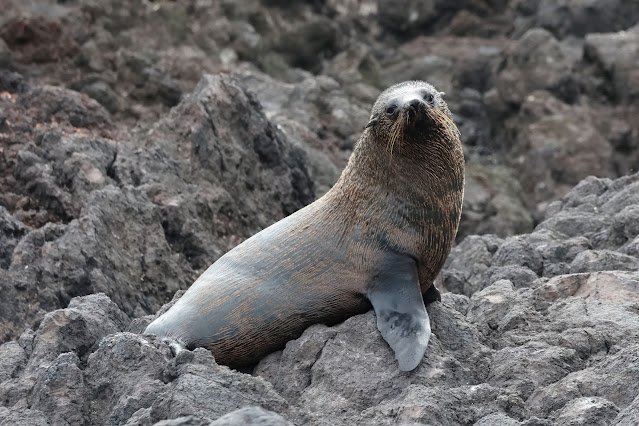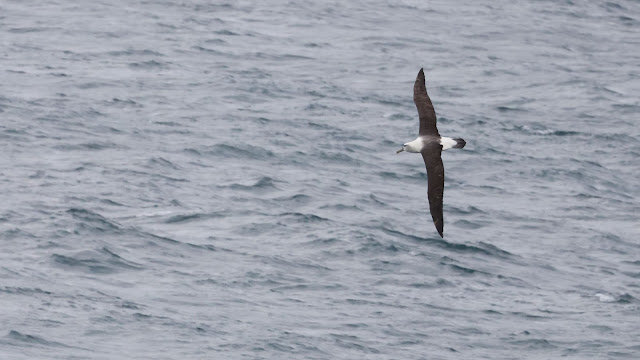Our final New Zealand land stop was at Port Chalmers, this time we had docked and could walk off the ship. It was a lovely morning and after breakfast we left the Silver Whisper and joined a coach that took us around the port and then to a small boat that would take us out into the Otago harbour.
Otago Harbour is the natural harbour of Dunedin,
New Zealand, consisting of a long, much-indented stretch of generally navigable
water separating the Otago Peninsula from the mainland.
The harbour was formed from the drowned remnants of the
giant Dunedin Volcano, centred close to what is now Port Chalmers. The
remains of this violent origin can be seen in the basalt of the
surrounding hills. The ancient and
modern channel runs along the western side of the harbour, the eastern side
being shallow, with large sandbanks exposed at low tide.
The conditions were very calm and this contributed to the sighting of a Little Blue Penguin that was swimming in the mid channel.
Sometimes known as the Fairy Penguin, they are the smallest species of Penguin. The name "blue" comes from the slate blue plumage.
As we edged closer, the penguin put on a turn of speed and headed towards the shallow water of the harbour.
While Otago Harbour might have the appearance of an
excellent deep-water port, it was not naturally suited to such a role,
especially in the early days of settlement when ships needed to dock close to
the city. The flat land at the southern end of the harbour and close to the
isthmus of Otago Peninsula was ideally suited for a city (and was the site for
Dunedin), but the harbour itself could naturally accommodate deep-drafted ships
only as far as Port Chalmers.
As the city grew, and particularly with the increase in
commerce that developed following the Otago Gold Rush of the 1860s,
it became desirable to provide a means for ships to reach the city's wharves.
Though a contentious and expensive decision, it was agreed to dredge a channel
along the northwestern side of the harbour. The channel was finally opened on
30 December 1881. The initial channel was narrow and shallow, and did not get
off to an auspicious start, as the Union Steam Ship Company's SS Penguin,
the first ship to use it, was temporarily grounded while using it. The channel
was officially named the Victoria Channel by Keith Ramsay, chairman of the
Otago Harbour Board. A significant area
at the head of the harbour — much of it referred to as the Southern
Endowment — has been reclaimed since the founding of Dunedin,
primarily for industrial use.
Remains of the extinct volcano.
As we headed towards the mouth of the harbour, a New Zealand Sea Lion was sleeping on the beach, but lifted its head to see what we were about.
Once known as Hooker's Sea Lion, it is endemic to New Zealand.
It was named 'Hooker's sea lion after Sir Joseph
Hooker, a botanist with a British Antarctic expedition which arrived in the
Aucklands in 1844.
Although the New Zealand sea lion is similar in size and
appearance to its geographical neighbour the Australian sea lion (Neophoca
cinerea), the two species are not, in fact, closely related genetically. Males are black or dark brown, and mature
bulls have a mane of rough hair about their shoulders. Females are silver-grey dorsally and creamy
ventrally, although they appear pale brown when dry towards the end of the
year.
The harbour is internationally important for the only breeding colony of the Southern Royal Albatross on mainland New Zealand, all other colonies are on the more remote islands. The colony is monitored and managed, looking to ensure there are no predators. The colony has been successful with numbers growing year on year.
They prefer to nest on tussock
grassland, plateaus, or ridges, and will lay one egg biennially.
This will normally take place in November or December. Both parents will
incubate the egg, and rear the young. After they are born it takes about 240
days for a baby to grow its wings fully and fly by itself. There is very low
mortality rates of the laid eggs once the parents settle in
Unfortunately the calm conditions that allowed us to see the Little Penguin meant that the Albatrosses were not flying. So after waiting to see if they would appear, we moved on. Another endemic New Zealand species, the Otago Shag, or Bronze Cormorant.
Moving out into the open water we had a different view of the nesting Southern Royals.
On the rocks were the New Zealand Fur Seals. These fur seals can be distinguished from the sea lions by
their pointy nose and smaller size. In New Zealand, fur seals also tend to be
found on rocky shorelines, whereas sea lions prefer sandy beaches.
This pointy-nosed seal has long pale whiskers and a body
covered with two layers of fur. Their coat is dark grey-brown on the back, and
lighter below; when wet, they look almost black. In some animals the longer
upper hairs have white tips which give the animal a silvery appearance.
Fur seals feed almost exclusively at night, when prey is
closer to the surface, as deep as 163 m during summer.Their summer foraging is
concentrated over the continental shelf, or near the slope. They will dive
continuously from sundown to sunrise.
In autumn and winter, they dive much deeper, with many dives
greater than 100 m. At least some females dive deeper than 240 m, and from
satellite tracking they may forage up to 200 km beyond the continental slope in
water deeper than 1000 m.
Young seals were mostly present on the rocks.
The view of the lighthouse and the Albatross breeding colony.
We headed out into the open water in the hope of finding a Southern Royal. But the only Albatross we could find on the water was a Shy Albatross.
We were able to get very close, close enough to get a nice portrait.
We got a little too close.
But it didn't go far, settling on the water once again.
The Shy Albatross finally took off.
Heading back into the harbour, the clouds were interesting above the cliffs.
An Otago Shag, showing the different plumage variations.
In the afternoon we caught a bus into Dunedin. First stop was the Railway Station.
The Dunedin Railway Station is one of the city’s most
prominent architectural landmarks, taking pride of place in the central city.
Dating back to 1906, this magnificent Flemish Renaissance-style edifice
features white Oamaru limestone facings on black basalt rock, giving it a
dramatic air and it’s characteristic ‘Gingerbread House’ appearance.
Fitted out in the lavish style of the times, the booking
hall alone features a mosaic floor of almost 750,000 tiles of Royal Doulton
porcelain. The sheer size, grandiose style and rich embellishments of the
station earned architect George Troup the nickname of Gingerbread George.
The gardens outside the station.
St Paul's Cathedral in the centre of Dunedin.
As we left Port Chalmers we passed the lighthouse and the Albatross colony.
As we headed out into the deeper water there was a feeding frenzy on the water with Shearwaters and Gulls.
And the frenzy caught the attention of a Shy Albatross.
It had a look at what was going on, but didn't stop.
And headed off with wing tip trailing in the water.
And as the light faded a flying Southern Royal Albatross at last.
There was a warning from the captain as we left port that we were likely to experience some rough seas overnight as we rounded the southern tip of New Zealand on our way to Milford Sound. It couldn't be too bad, could it?




















































No comments:
Post a Comment